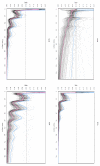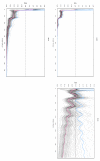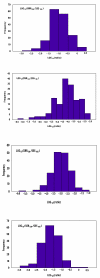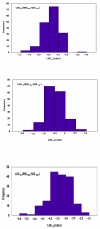Density-independent population projection trajectories of chromosome-substituted lines resistant and susceptible to organophosphate insecticides in Drosophila melanogaster
- PMID: 15563373
- PMCID: PMC535562
- DOI: 10.1186/1471-2156-5-31
Density-independent population projection trajectories of chromosome-substituted lines resistant and susceptible to organophosphate insecticides in Drosophila melanogaster
Abstract
Background: Seasonal fluctuations in susceptibility to organophosphate insecticides were observed in the Katsunuma population of Drosophila melanogaster for two consecutive years; susceptibility to three organophosphates tended to increase in the fall. To examine the hypothesis that variation in fitness among resistant and susceptible genotypes could trigger the change of genetic constitution within the fall population, we investigated density-independent population projection trajectories starting from single adult females with characteristics of chromosome-substituted lines resistant and susceptible to the three organophosphates.
Results: Density-independent population projection trajectories, expressed as the ratios of the number of each chromosome-substituted line to that of line SSS, for which all chromosomes were derived from the susceptible line, showed significant declines in numbers with time for all the resistant chromosome-substituted lines.
Conclusion: The declining tendency in the density-independent population projection trajectories of the resistant chromosome-substituted lines could explain the simultaneous decline in the levels of resistance to the three organophosphates, observed in the Katsunuma population in the fall.
Figures







Similar articles
-
Seasonal fluctuation in susceptibility to insecticides within natural populations of Drosophila melanogaster. II. Features of genetic variation in susceptibility to organophosphate insecticides within natural populations of D. melanogaster.Genes Genet Syst. 2006 Aug;81(4):273-85. doi: 10.1266/ggs.81.273. Genes Genet Syst. 2006. PMID: 17038799
-
The comparison of intrinsic rates of increase among chromosome-substituted lines resistant and susceptible to organophosphate insecticides in Drosophila melanogaster.Genes Genet Syst. 2003 Oct;78(5):373-82. doi: 10.1266/ggs.78.373. Genes Genet Syst. 2003. PMID: 14676428
-
Genetic basis of cross-resistance to three organophosphate insecticides in Drosophila melanogaster (Diptera: Drosophilidae).J Econ Entomol. 2002 Oct;95(5):871-7. doi: 10.1093/jee/95.5.871. J Econ Entomol. 2002. PMID: 12403411
-
Drosophila acetylcholinesterase: mechanisms of resistance to organophosphates.Chem Biol Interact. 1993 Jun;87(1-3):233-8. doi: 10.1016/0009-2797(93)90047-3. Chem Biol Interact. 1993. PMID: 8343979 Review.
-
Resistance evolution in Drosophila: the case of CYP6G1.Pest Manag Sci. 2017 Mar;73(3):493-499. doi: 10.1002/ps.4470. Epub 2016 Dec 21. Pest Manag Sci. 2017. PMID: 27787942 Review.
References
-
- Crow JF. Genetics of insect resistance to chemicals. Ann Rev Entomol. 1957;2:227–246. doi: 10.1146/annurev.en.02.010157.001303. - DOI
Publication types
MeSH terms
Substances
LinkOut - more resources
Full Text Sources
Molecular Biology Databases

